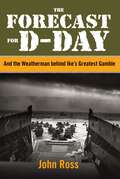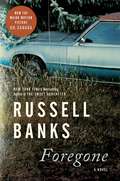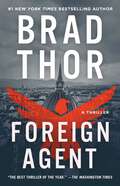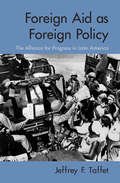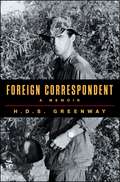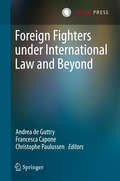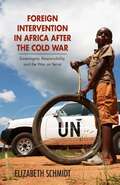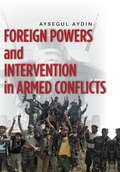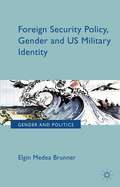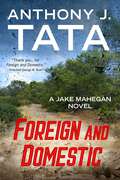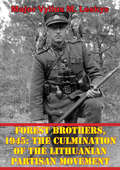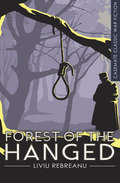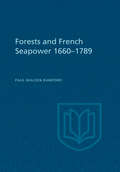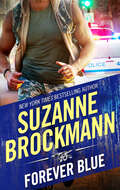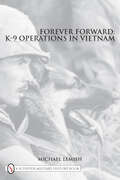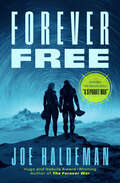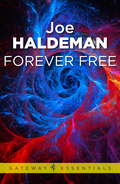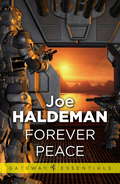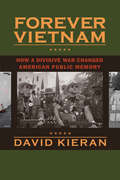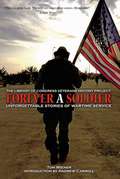- Table View
- List View
Forecast for D-day: And the Weatherman behind Ike's Greatest Gamble
by John E. RossMonday, June 5, had long been planned for launching D-day, the start of the campaign to liberate Nazi-held Western Europe. Yet the fine weather leading up to the greatest invasion the world would ever see was deteriorating rapidly. Would it hold long enough for the bombers, the massed armada, and the soldiers to secure beachheads in Normandy? That was the question, and it was up to Ike’s chief meteorologist, James Martin Stagg, to give him the answer. On the night of June 4, the weather hung on a knife’s edge. The three weather bureaus advising Stagg—the US Army Air Force, the Royal Navy, and the British Met Office—each provided differing forecasts. Worse, leading meteorologists in the USAAF and Met Office argued stormily. Stagg had only one chance to get it right. Were he wrong, thousands of men would perish, secrecy about when and where the Allies would land would be lost, victory in Europe would be delayed for a year, and the Communists might well take control of the continent.
Foregone: A Novel
by Russell BanksThe inspiration for the Major Motion Picture O, Canada directed by Paul Schrader and starring Richard Gere, Uma Thurman, Jacob Elordi, and Michael Imperioli.A searing novel about memory, abandonment, and betrayal from the acclaimed and bestselling Russell Banks "During a career stretching almost half a century, Russell Banks has published an extraordinary collection of brave, morally imperative novels. . . . In this complex and powerful novel, we come face to face with the excruciating allure of redemption." —Washington PostAt the center of Foregone is famed Canadian American leftist documentary filmmaker Leonard Fife, one of sixty thousand draft evaders and deserters who fled to Canada to avoid serving in Vietnam. Fife, now in his late seventies, is dying of cancer in Montreal and has agreed to a final interview in which he is determined to bare all his secrets at last, to demythologize his mythologized life. The interview is filmed by his acolyte and ex–star student, Malcolm MacLeod, in the presence of Fife’s wife and alongside Malcolm’s producer, cinematographer, and sound technician, all of whom have long admired Fife but who must now absorb the meaning of his astonishing, dark confession.Imaginatively structured around Fife’s secret memories and alternating between the experiences of the characters who are filming his confession, the novel challenges our assumptions and understanding about a significant lost chapter in American history and the nature of memory itself. Russell Banks gives us a daring and resonant work about the scope of one man’s mysterious life, revealed through the fragments of his recovered past.
Foreign Agent: A Thriller (The Scot Harvath Series #15)
by Brad Thor&“The best thriller of the year...an exciting and entertaining read.&” —The Washington Times &“A top-notch thriller.&” —Bill O&’Reilly From #1 New York Times and #1 Wall Street Journal bestselling author Brad Thor—a brilliant thriller as &“current as tomorrow&’s headlines&” (Dan Brown, #1 New York Times bestselling author). Terrorism in Europe has spun out of control. The United States has decided on a dramatic response. Now, the CIA needs a very special kind of operative.Scot Harvath has exactly the skills the CIA is looking for. He&’s a former U.S. Navy SEAL with extensive experience in espionage. Working for a private intelligence company, he will provide the CIA, and more important, the President, with absolute deniability. But deep within the Russian Caucasus, Moscow also has its own special kind of operative. As a child, Sacha Baseyev endured an unimaginable horror. Today, he lives and breathes for only one reason—to kill. And he will kill as many Americans as it takes to accomplish his mission. When a clandestine American operations team is ambushed near Syria, all signs point toward a dangerous informant in Brussels. But as Harvath searches for the man, he uncovers another actor—a rogue player hell-bent on forcing America&’s hand and drawing it into a confrontation deadlier than anyone could have imagined. As the attacks mount, and terror is brought to the very doorstep of the White House, Harvath finds himself in the race of his life. From Vienna, Brussels, and Berlin, to Malta, Jordan, and Syria—he will push himself beyond the edge in order to confront one of the greatest evils the world has ever known.
Foreign Aid as Foreign Policy: The Alliance for Progress in Latin America
by Jeffrey TaffetForeign Aid as Foreign Policy presents a wide-ranging, thoughtful analysis of the most significant economic-aid program of the 1960s, John F. Kennedy’s Alliance for Progress. Introduced in 1961, the program was a ten-year, multi-billion-dollar foreign-aid commitment to Latin American nations, meant to help promote economic growth and political reform, with the long-term goal of countering Communism in the region. Considering the Alliance for Progress in Chile, Brazil, the Dominican Republic, and Colombia, Jeffrey F. Taffet deftly examines the program’s successes and failures, providing an in-depth discussion of economic aid and foreign policy, showing how policies set in the 1960s are still affecting how the U.S. conducts foreign policy today. This study adds an important chapter to the history of US-Latin American Relations.
Foreign Correspondent
by H.D.S. GreenwayDavid Greenway, a journalist's journalist in the tradition of Michael Herr, David Halberstam, and Dexter Filkins. In this vivid memoir, he tells us what it's like to report a war up close.Reporter David Greenway was at the White House the day Kennedy was assassinated. He was in the jungles of Vietnam in that war's most dangerous days, and left Saigon by helicopter from the American embassy as the city was falling. He was with Sean Flynn when Flynn decided to get an entire New Guinea village high on hash, and with him hours before he disappeared in Cambodia. He escorted John le Carre around South East Asia as he researched The Honourable Schoolboy. He was wounded in Vietnam and awarded a Bronze Star for rescuing a Marine. He was with Sidney Schanberg and Dith Pran in Phnom Penh before the city descended into the killing fields of the Khmer Rouge. Greenway covered Sadat in Jerusalem, civil war and bombing in Lebanon, ethnic cleansing and genocide the Balkans, the Gulf Wars (both), and reported from Afghanistan and Iraq as they collapsed into civil war. This is a great adventure story--the life of a war correspondent on the front lines for five decades, eye-witness to come of the most violent and heroic scenes in recent history.
Foreign Fighters under International Law and Beyond
by Christophe Paulussen Andrea De Guttry Francesca CaponeThis book offers various perspectives, with an international legal focus, on an important and underexplored topic, which has recently gained momentum: the issue of foreign fighters. It provides an overview of challenges, pays considerable attention to the status of foreign fighters, and addresses numerous approaches, both at the supranational and national level, on how to tackle this problem. Outstanding experts in the field - lawyers, historians and political scientists - contributed to the present volume, providing the reader with a multitude of views concerning this multifaceted phenomenon. Particular attention is paid to its implications in light of the armed conflicts currently taking place in Syria and Iraq. Andrea de Guttry is a Full Professor of International Law at the Scuola Superiore Sant'Anna, Pisa, Italy. Francesca Capone is a Research Fellow in Public International Law at the Scuola Superiore Sant'Anna. Christophe Paulussen is a Senior Researcher at the T. M. C. Asser Instituut in The Hague, the Netherlands, and a Research Fellow at the International Centre for Counter-Terrorism - The Hague.
Foreign Intervention In Africa After The Cold War: Sovereignty, Responsibility, And The War On Terror (Research In International Studies, Global And Comparative Studies)
by Elizabeth SchmidtIn Foreign Intervention in Africa after the Cold War--interdisciplinary in approach and intended for nonspecialists--Elizabeth Schmidt provides a new framework for thinking about foreign political and military intervention in Africa, its purposes, and its consequences. She focuses on the quarter century following the Cold War (1991-2017), when neighboring states and subregional, regional, and global organizations and networks joined extracontinental powers in support of diverse forces in the war-making and peace-building processes. During this period, two rationales were used to justify intervention: a response to instability, with the corollary of responsibility to protect, and the war on terror. <p><p> Often overlooked in discussions of poverty and violence in Africa is the fact that many of the challenges facing the continent today are rooted in colonial political and economic practices, in Cold War alliances, and in attempts by outsiders to influence African political and economic systems during the decolonization and postindependence periods. Although conflicts in Africa emerged from local issues, external political and military interventions altered their dynamics and rendered them more lethal. Foreign Intervention in Africa after the Cold War counters oversimplification and distortions and offers a new continentwide perspective, illuminated by trenchant case studies.
Foreign Planes in the Service of the Luftwaffe
by Jean-Louis RobaThis pictorial history shows the full extent of captured foreign aircraft used by Nazi Germany during WWII. No air force in the Second World War would make more use of captured planes than the Luftwaffe. With this in mind, military historian Jean-Louis Roba has tracked down hundreds of such aircraft with rare images that illustrate their uses, careers, and eventual fates. Foreign Planes in the Service of the Luftwaffe covers the complete history of this practice from its inception in the prewar years to the end of the Second World War. Roba&’s significant research on the topic debunks myths about how prepared for war the Germans were in 1939. This volume demonstrates how important captured planes—a decidedly unreliable resource—would become to the Luftwaffe. Translated into English for the first time, Roba&’s investigative work is supported by more than a hundred pictures of the planes themselves, and gives a rare opportunity to see British and American planes repainted in German colors and symbols.
Foreign Powers and Intervention in Armed Conflicts
by Aysegul AydinIntervention in armed conflicts is full of riddles that await attention from scholars and policymakers. This book argues that rethinking intervention-redefining what it is and why foreign powers take an interest in others' conflicts-is of critical importance to understanding how conflicts evolve over time with the entry and exit of external actors. It does this by building a new model of intervention that crosses the traditional boundaries between economics, international relations theory, and security studies, and places the economic interests and domestic political institutions of external states at the center of intervention decisions. Combining quantitative and qualitative evidence from both historical and contemporary conflicts, including interventions in both interstate conflicts and civil wars, it presents an in-depth discussion of a range of interventions-diplomatic, economic, and military-in a variety of international contexts, creating a comprehensive model for future research on the topic.
Foreign Security Policy, Gender, and US Military Identity
by Elgin Medea BrunnerThe concept of 'othering' which can be understood as the process of differentiation from the Self has been a basic tenet of the war story since war stories were first told. This practise of deliberate differentiation is indicative of the fact that war stories are essentially about the production of identity. The aim of this book, therefore, is to unravel some of the gendered ideologies that underpin the link between state identity and foreign security policy by looking at a certain case, state and foreign security policy. In particular this volume explores the identity of the United States through military documents on perception management in conflict from 1991-2007 shedding light on the 'othering' and the 'selfing' that occurs in these particular war stories. In doing so it lays bare the gendered ideologies that underpins US identity between these years as well as exploring potential spaces for alternatives. Thus, this book ventures a detailed and unique look at a particular aspect of the gendered reproduction of the state.
Foreign and Domestic (A Jake Mahegan Thriller #1)
by Anthony J. Tata&“ABSOLUTELY FANTASTIC…PULSE-POUNDING.&” —Brad Thor #1 New York Times bestselling author One year ago, Captain Jake Mahegan led a Delta Force team into Afghanistan to capture an American traitor working for the Taliban. The mission ended in tragedy. The team was infiltrated and decimated by a bomb. An enemy prisoner was killed. Mahegan was dismissed from service—dishonored forever. Now, haunted by the incident, Mahegan is determined to clear his name. The military wants him to stand down. But when the American Taliban returns to domestic soil—headed by the traitor who ruined his life—Mahegan is the only man who knows how to stop him. Outside the law. Under the radar. Out for vengeance… &“I thoroughly enjoyed it…well done! Thank you…for Foreign and Domestic.&” --President George Bush &“Thrilling read!&”--Former Texas Governor Rick PerryBrigadier General Tata donates a portion of his earnings to the USO Metro DC, the North Carolina Heroes Fund, and the Michael Murphy Foundation.
Forensic Seismology and Nuclear Test Bans
by Alan DouglasWith the signing in 1996 of the Comprehensive Nuclear Test Ban Treaty, interest has grown in forensic seismology: the application of seismology to nuclear test ban verification. This book, based on over 50 years of experience in forensic seismology research, charts the development of methods of seismic data analysis. Topics covered include: the estimation of seismic magnitudes, travel-time tables and epicentres; seismic signal processing; and the use of seismometer arrays. Fully illustrated with seismograms from explosions and earthquakes, the book demonstrates methods and problems of visual analysis. Each chapter provides exercises to help the reader familiarise themselves with practical issues in the field of forensic seismology, and figures and solutions to exercises are also available online. The book is a key reference work for academic researchers and specialists in the area of forensic seismology and Earth structure, and will also be valuable to postgraduates in seismology and solid earth geophysics.
Forest Brothers, 1945: The Culmination Of The Lithuanian Partisan Movement
by Major Vylius M. LeskysAlthough the resistance effort maintained its strength ideologically, the Lithuanian partisan movement never recovered from the culminating point in 1945 because of a shortfall in resources, a lack of external support, and the inability of resistance leadership to adapt rapidly enough against a comprehensive Soviet assimilation campaign.While many authors argue that the high point in the Lithuanian partisan war occurred between 1946 and 1947, the totality of evidence points towards a culmination in 1945 from which the effort never recovered. This culminating point may be attributed to a miscalculation of partisan resources on the part of their leadership as well as a lack of external support. The main reason for achieving culmination, however, rested in the inability of partisans to fight a conventional war against a massive, combined arms Soviet force. Mass deportations between three separate occupations and a wave of 60,000 escapees created a vacuum of political, military and moral leadership. Compounded with the realization that there would be no external support from the democratic West, the will of the Lithuanians was bent by the Soviet campaign. Ultimately, the numbers of partisans killed, captured or given amnesty by Soviet forces reflect an apex in military capability in 1945 that drastically diminished thereafter.The pinnacle of partisan effort in 1945 clearly represents a culminating point that forced the Lithuanian resistance movement to shift their operations drastically. Ultimately, based on the totality of evidence, the 1945 culminating point splits the resistance into two stages: 1) 1944-1945-conventional war operations, a period of traditional offensive warfare by an organized partisan movement; and 2) 1946-1953-irregular warfare operations, a period of unremitting decline by a significantly diminished resistance, relegated to a more defensive posture and small scale offensive operations.
Forest of the Hanged: A Novel (Casemate Classic War Fiction #11)
by Liviu RebreanuA World War I soldier is torn between his duty, his country, and his conscience in this work of &“classic war fiction&” (Books Monthly). When the First World War broke out, Apostol Bologa left his home in Romania and joined the Austro-Hungarian army with grand visions of battle, glory, and honor. Instead, the young officer finds himself serving on a near-perfunctory tribunal that sentences deserters and other reprobates to hanging in a small dark forest just behind the Eastern Front. At first Bologa performs his duties with staunch military bearing, but the weight of the dead slowly begins to toll on his mind and spirit. For as his fellow soldiers are being cut down by the thousands on the battlefields, his only contribution to the effort is killing men one by one for reasons that grow ever more foreign and dubious—until he finds himself lost in the very forest of the dead he helped grow . . . with little hope for his own salvation.
Forests and French Sea Power, 1660-1789
by Paul Walden BamfordBy choosing to concentrate upon discovering what forest resources were available to the French navy during the ancien régime and what use it was able to make of them, Mr. Bamford has not only provided the first monograph on that subject in the English language, but has gone far toward explaining why France was the loser in the long duel with England for the control of commerce and the extension of empire. <P><P> Two years of research in the Archives Nationales and in the Archives de la Marine in Paris, Toulon, and Rochefort enabled him to draw on contemporary sources of information of which little, if any, use has been made before, and a further year of research in the libraries of New York City, particularly in the rich Proudfit Naval Collection, also yielded new material. It is Mr. Bamford's achievement to have handled this vast store of primary sources with such skill and judgement that the reader, by turning over letters from disgruntled forest proprietors, reports from harassed maîtres on the trickery and recalcitrance of the peasants, instructions from the top echelon of the navy to inspectors in the forests, and a variety bills, receipts, and memoranda, is given at first hand an appreciation of the difficulties faced by the navy in trying to obtain timber and masts of the choice quality required for building ships-of-the-line. The navy had to compete with the merchant marine and with industrial and private users of fuel for supplies that were continually being depleted by mismanagement and by the conversion of forests to arable land. Measures, superficially admirable, for conserving the forests are found on closer examination to be at once over-precise and not properly enforced. Transport, even in a country so abundantly supplied with navigable rivers as France, was expensive and difficult.<P>Not only historians, but scholars in the field of forestry, economics, geography, agriculture, and transport will find this book illuminating.
Forever
by Rebecca RoyceDevin Owen has come back from the Dragon Wars a changed Werewolf. For one thing, he's lost his wolf side as well as much of his desire to live. He spends most of his life doped up to handle the pain from his injured leg. Lena Knox knew the moment she met Devin that he was her mate. But, she’d been a child at the time and he hadn't noticed her at all. Now, all grown up, she wants Devin to be the wolf she’s waited for. Not that she has a lot of time for longing with life and home crumbling around her. A couple of heated encounters draw them together, but is it enough to overcome the war wounds they both carry? Or will an outside enemy destroy them before they get the chance to find forever? This is a re-released title.
Forever Blue: Prince Joe Forever Blue Frisco's Kid (Tall, Dark and Dangerous #2)
by Suzanne Brockmann“Alpha Squad swings into action for a second time in Brockmann’s latest powerhouse romance . . . [An] explosive, totally outstanding love story.” —Romantic TimesThe guy next door is home to stay—but can he be trusted?Blue McCoy was once the hero of Lucy Tait’s teenaged dreams—quiet, dark and dangerous. But after high school he left Hatboro Creek, South Carolina, to join the military. Now, years later, a brooding Navy SEAL, Blue is back in town.Lucy, now a no-nonsense police officer, is certainly not the person Blue remembers. And when he’s accused of murder and Lucy is assigned his case, their brief affair becomes part of an extensive investigation where the stakes are vital: Blue’s freedom—and maybe Lucy’s heart.Praise for Suzanne Brockmann and her novels“The name Brockmann means romantic suspense!” —RT Book Reviews“Brilliant sexual chemistry, laugh-out-loud humor, riveting action, and flawlessly rendered characters.” —Library Journal (starred review)“Jam-packed with adrenaline-fueled action and sizzling sexual tension.” —Booklist (starred review)
Forever Forward: K-9 Operations in Vietnam
by Michael Lemish“Forever Forward” is the first in-depth account of K-9 Operations during the Vietnam War, and provides a behind the scenes look at how Allied forces employed dog teams in a variety of roles, the evolution of the United States military working dog program, and the aftermath of Vietnam. The 4,000 dogs that served with our men in Vietnam in every service branch are America’s unsung heroes. American dog teams averted over 10,000 casualties and worked as scouts, sentries, trackers, mine, and tunnel detectors. They were so effective the Viet Cong even placed a bounty on them. Heroes yes, but our own government left most of them behind to an unknown fate.
Forever Free
by Joe HaldemanWhen the Forever War was published in the early 1980s it took the science fiction field by storm and won both the Hugo and the Nebula Awards. Twenty years later Haldeman published Forever Peace which won the same two awards. Now in Forever Free, Haldeman continues his exploration of the nature of war, the meaning of life and the value of freedom. this is a remarkable series and a remarkable book.
Forever Free (The Forever War Series #2)
by Joe HaldemanCivilian life in space yields epic challenges for two married ex-soldiers in this visionary science fiction adventure sequel—now with a bonus story. Ranked at the top of virtually every list of the greatest military science fiction adventures ever written is Joe Haldeman&’s Hugo and Nebula Award–winning classic, The Forever War, now celebrating its 50th anniversary. In Forever Free, the Science Fiction Writers of America Grand Master and author of the acclaimed Worlds series returns to that same volatile universe where human soldiers once engaged the alien Taurans in never-ending battle. While loyal soldier William Mandella was fighting for the survival of the human race in a distant galaxy, thousands of years were passing on his home planet, Earth. Then, with the end of the hostilities came the shocking realization that humanity had evolved into something he did not recognize. Offered the choice of retaining his individuality or becoming part of the genetically modified shared Human hive-mind, Mandella chose exile, joining other veterans of the Forever War seeking a new life on a wasteland world they called Middle Finger. Making a home for themselves in this half-frozen hell, Mandella and his life partner, Marygay, have survived into middle age, raising a son and a daughter in the process. Now, the dark truth about the colonists&’ ultimate role in the continuation of the Human group mind will force Mandella and Marygay to take desperate action as they hijack an interstellar vessel and set off on a frantic escape across space and time. But what awaits them upon their return is a mystery far beyond all human—or Human—comprehension . . . In Forever Free, Joe Haldeman&’s stunning vision of humankind&’s far future reaches its enthralling conclusion in a masterwork of speculation from the mind and heart of one of the undisputed champions of hard science fiction. And in the bonus story included in this volume, &“A Separate War,&” Marygay, reassigned and separated from her lover, Mandella, continues fighting in military engagements across the stars—all the while planning how she and Mandella can reunite despite the time and space between them.
Forever Free: Forever War Book 3 (FOREVER WAR)
by Joe HaldemanWilliam Mandela is a genetic throwback, one of the small group of humans who fought and survived the Forever War. They returned to find humanity has evolved into a group mind called Man. Surrounded by a society that is too autocratic and intrusive, living a dull existence which cannot compare to the certainties of combat and feeling increasingly alienated, the veterans plan an escape to the future by means of space travel and relativity. But when their ship starts to fail, their journey becomes a search for the Unknown, the elusive entity responsible.
Forever Home: A Novel (Dogwood County #2)
by Elysia WhislerIf home is where the heart is, Dogwood County may have just what Delaney Monroe needs Newly retired from the Marine Corps, Delaney is looking for somewhere to start over. It&’s not going to be easy, but when she finds the perfect place to open her dream motorcycle shop, she goes for it. What she doesn&’t expect is an abandoned pit bull to come with the building. The shy pup is slow to trust, but Delaney is determined to win it over. Detective Sean Callahan is smitten from the moment he sees Delaney, but her cool demeanor throws him off his game. When her late father's vintage motorcycle is stolen from Delaney's shop, Sean gets to turn up in his element: chasing the bad guy and showing his best self to a woman who&’s gotten under his skin in a bad way. Delaney isn't used to lasting relationships, but letting love in—both human and canine—helps her see that she may have found a place she belongs, forever."Complex, quietly compelling characters… A poignant reminder that &‘home&’ is often more than a place." —Maggie Wells, author of Love GameDogwood CountyBook 1: Rescue YouBook 2: Forever Home
Forever Peace: Forever War Book 2 (FOREVER WAR)
by Joe HaldemanIn the year 2043, the Ngumi War rages. Limited nuclear strikes have been used on Atlanta and two enemy cities, but the war goes on, fought by 'soldierboys' - indestructible war machines operated by remote control by soldiers hundreds of miles away.Julian Class is one of these soldiers, and for him war is truly hell. The psychological strain of being jacked-in to his soldierboy - and the genocidal results - are becoming too much to bear. Now he and his companion, Dr Amelia Harding, have made a terrifying scientific discovery, which could literally take the universe back to square one. Except that for Julian, the discovery isn't so much terrifying as tempting...Winner of the Hugo Award for best novel, 1998Winner of the Nebula Award for best novel, 1998Winner of the John W. Campbell Award for best novel, 1998
Forever Vietnam: How a Divisive War Changed American Public Memory
by David KieranFour decades after its end, the American war in Vietnam still haunts the nation’s collective memory. Its lessons, real and imagined, continue to shape government policies and military strategies, while the divisions it spawned infect domestic politics and fuel the so-called culture wars. In Forever Vietnam, David Kieran shows how the contested memory of the Vietnam War has affected the commemoration of other events, and how those acts of remembrance have influenced postwar debates over the conduct and consequences of American foreign policy. Kieran focuses his analysis on the recent remembrance of six events, three of which occurred before the Vietnam War and three after it ended. The first group includes the siege of the Alamo in 1836, the incarceration of Union troops at Andersonville during the Civil War, and the experience of American combat troops during World War II. The second comprises the 1993 U.S. intervention in Somalia, the crash of United Airlines Flight 93 on September 11, 2001, and the Iraq and Afghanistan wars. In each case a range of actors—military veterans, policymakers, memorial planners, and the general public—used memorial practices associated with the Vietnam War to reinterpret the contemporary significance of past events. A PBS program about Andersonville sought to cultivate a sense of national responsibility for the My Lai massacre. A group of Vietnam veterans occupied the Alamo in 1985, seeing themselves as patriotic heirs to another lost cause. A World War II veteran published a memoir in 1980 that reads like a narrative of combat in Vietnam. Through these and other examples, Forever Vietnam reveals not only the persistence of the past in public memory but also its malleability in the service of the political present.
Forever a Soldier: Unforgettable Stories of Wartime Service
by Tom WienerForever a Soldier captures the personal side of war in 37 extraordinary narratives that bear eloquent witness to both the life-changing experience of battle and to the unflagging spirit that sustained countless ordinary Americans plunged into the bloody conflicts of the deadliest, most destructive century in human history. Culled from letters, diaries, private memoirs, and oral histories collected by the Library of Congress Veterans History Project, their stories paint an unforgettable group portrait of our country's armed forces. <P><P>Some tell of frontline action: a doughboy's 1918 baptism of fire: a battleship gunner's grim duel with Japanese planes; a female fighter pilot's capture by Iraqis during the Gulf War. Others evoke moments of relief and reflection, or recall deeply moving episodes: two wounded soldiers—one German, one American—clasping hands in the wordless brotherhood of pain; a POW whose faith gave him the strength to endure torture in the notorious "Hanoi Hilton;" a GI's lifelong grief for a buddy killed on the last day of World War II in Europe. <P><P>Forever a Soldier presents famous incidents like the sinking of the USS Indianapolis and her survivors' terrifying ordeal in the shark-infested Pacific, and heroic figures like John McCain, but it's the long-untold stories of unheralded patriots that best reveal the universal truths of war: courage and fear, horror and exhilaration, sorrow and triumph—the shared legacy of every American veteran, and a debt of honor the rest of us must respect but can never repay.
